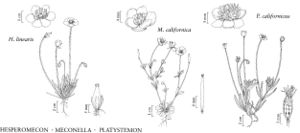familyPapaveraceae
genusHesperomecon
Show Lower Taxa
Hesperomecon
Pittonia 5: 146. 1903.
Etymology: Greek hesperos, evening or western, and mecon, poppy
Treatment appears in FNA Volume 3.
| Taxon | Illustrator ⠉ | |
|---|---|---|
 | Platystemon californicus Hesperomecon linearis Meconella californica | John Myers John Myers John Myers |
Herbs annual, short-caulescent, subscapose, distinctly pubescent, from fibrous-roots; sap clear. Stems leafy at and near base, erect, branching from base. Leaves opposite, sessile; blade broadly linear, unlobed. Inflorescences axillary or terminal, 1-flowered; bracts absent; bud nodding. Flowers: sepals 3, with overlapping, loosely connivent flaps; petals 6, occasionally more on robust specimens; stamens 12 or more, usually in several series; filaments dilated distally; pistil 3-carpellate; ovary 1-locular; stigmas 3. Capsules erect, 3-valved, dehiscing from apex. Seeds many, aril absent. x = 7.
Discussion
Species 1 (1 in the flora).
Selected References
None.
Lower Taxa
... more about "Hesperomecon"
perigynous +
absent +
branching +
erect +
unlobed +
absent +
nodding +
3-valved +
dehiscing +
erect +
Calif. +
dilated +
capsular +
1-flowered +
sessile +
opposite +
perigynous +
distinct +
absent +
obovate +
2 times number of sepals +
3-carpellate +
parietal +
Pittonia +
1903 +
expanded +
clear +
sticky +
many +
1-seeded +
caducous +
obovate +
several +
robust +
leafy +
2;many +
absent +
Hesperomecon +
Papaveraceae +
genus +
annual +
pubescent +
small +